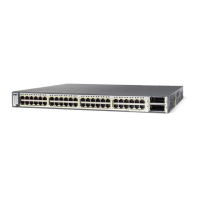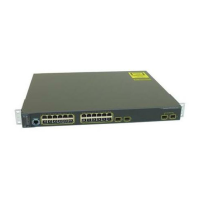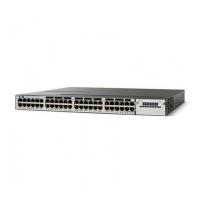2-472
Catalyst 3750-X and 3560-X Switch Command Reference
OL-29704-01
Chapter 2 Catalyst 3750-X and 3560-X Switch Cisco IOS Commands
police
police
Use the police policy-map class configuration command on the switch stack or on a standalone switch
to define a policer for classified traffic. A policer defines a maximum permissible rate of transmission,
a maximum burst size for transmissions, and an action to take if either maximum is exceeded. Use the
no form of this command to remove an existing policer.
police rate-bps burst-byte [exceed-action {drop | policed-dscp-transmit}]
no police rate-bps burst-byte [exceed-action {drop | policed-dscp-transmit}]
Syntax Description
Defaults No policers are defined.
Command Modes Policy-map class configuration
Command History
Usage Guidelines When configuring hierarchical policy maps, you can only use the police policy-map command in a
secondary interface-level policy map.
The port ASIC device, which controls more than one physical port, supports 256 policers on the switch
(255 user-configurable policers plus 1 policer reserved for internal use). The maximum number of
configurable policers supported per port is 63. Policers are allocated on demand by the software and are
constrained by the hardware and ASIC boundaries. You cannot reserve policers per port. There is no
guarantee that a port will be assigned to any policer.
To return to policy-map configuration mode, use the exit command. To return to privileged EXEC mode,
use the end command.
Policing uses a token-bucket algorithm. You configure the bucket depth (the maximum burst that is
tolerated before the bucket overflows) by using the burst-byte option of the police policy-map class
configuration command or the mls qos aggregate-policer global configuration command. You configure
how quickly (the average rate) the tokens are removed from the bucket by using the rate-bps option of
the police policy-map class configuration command or the mls qos aggregate-policer global
configuration command. For more information, see the software configuration guide for this release.
rate-bps Specify the average traffic rate in bits per second (b/s). The range is 1000000
to 1000000000.
burst-byte Specify the normal burst size in bytes. The range is 8000 to 1000000.
exceed-action drop (Optional) When the specified rate is exceeded, specify that the switch drop
the packet.
exceed-action
policed-dscp-transmit
(Optional) When the specified rate is exceeded, specify that the switch
changes the Differentiated Services Code Point (DSCP) of the packet to that
specified in the policed-DSCP map and then sends the packet.
Release Modification
12.2(53)SE2 This command was introduced.
